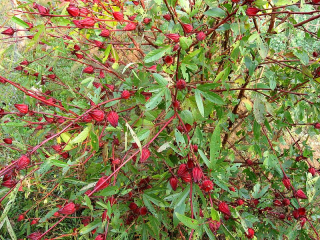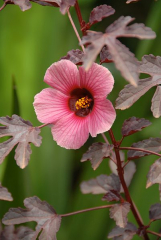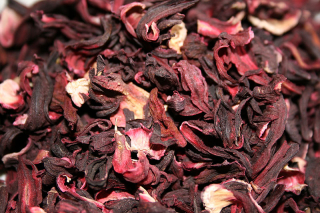Roselle, better known in Australia as Rosella (like the parrot, but less feathery) is an annual (or sometimes biennual), fast growing shrub in the hibiscus family. Like most hibiscus and mallows, it has edible leaves and flower petals, but Roselle is most famous for its edible calyx. The calyx, stems and leaves are acid and closely resemble the cranberry (Vaccinium spp.) in flavor. The calyx is used to make jams and sauces, and dried for tea. The tender young leaves may be cooked and eaten as a substitute for spinach, though somewhat spicier in flavour.
Young roselle shoots, leaves and calices are traditionally used as a cooked vegetable or finely cut and used in sauces in Africa. The leaves and fresh green calices are used to make a soup, which is rather mucilaginous in texture. Fibre from the stems may be used as a substitute for jute (fibres produced from the stem of Corchorus species).
Roselle grows into a small shrub, up to 2.5m tall, with smooth or nearly smooth, cylindrical, typically red stems. The leaves are generally lobed, with 3 – 5 points, and have distinctive reddish veins. The flowers are white to pale yellow with a dark red spot at the base of each petal, and turn pink as they wither at the end of the day. They are usually self-pollinating. The flowers have a stout, fleshy calyx, usually bright red, at the base, 1–2 cm wide. This becomes more prominant, crisp, and juicy after the flower has withered and while the fruit matures. This enlarged calyx fully encloses the seed pod, which is 1 – 2 cm long and green when immature. The mature seed pod is light brown, with 5 valves or segments, each of which contain 3 – 5 kidney-shaped, light-brown seeds.
Roselle grows easily from seed. The seedlings grow quickly, reaching about 30cm in height after 1 month. The plants goes through a 2 – 6 month vegetative growth phase before flowering begins. Leaf harvesting can begin 6 – 8 weeks after the seedlings emerge, and stimulates branching and leaf production. Seedlings may be raised in nursery beds and transplanted when 7-10 cm tall, but seeds are usually set directly in the field, 4 to 6 to a hill, the hills 1-2 m apart in rows 1.5-3 m apart. Roselle is often intercropped with other crops such as pearl millet, sorghum, groundnut, sweet potato, yam or cowpea. Roselle is susceptible to most diseases affecting cotton, and root and stem rot caused by several Phytophthora spp. lead to plant losses.
Plants reach maximum productivity in their first growing season, but can be pruned to achieve an early, although less substantial, harvest in their second year in subtropical climates. The fleshy pods are best removed when they can be picked easily from the bush by hand while they are still young and crisp; as the seedpods mature the calyx becomes tough and stringy. Once picked, the next task is to remove the calyx, the fleshy petals, from the seeds. It is a little time consuming, but they peel off quite easily. Use gloves because they seeds are prickly. The green seed pods are high in pectin, and can be used to assist in jam making.
Roselle Tea
The tea is very similar in flavour to rosehips and high in Vitamin C. To make it, strip off the red calyx and dry it in the solar dryer or a slow oven until leathery. Only two small pieces are needed per cup of hot water. Try mixing it with dried lemongrass, lemon verbena and dried organic orange peel, or with ginger or mint for a wonderful herb tea. It is also good as an iced tea.
Roselle Jam
2 kg roselle fruit (calyx and seedpods)
1 cup sugar for each cup of pulp
juice of 1 lemon
1 apple (peeled, cored, chopped)
- Place the seed pods in a saucepan, cover with water and bring to the boil. Simmer for around 40 minutes, or until the liquid becomes thick and gelatinous.Make sure the pods don’t break open. Strain through a sieve or cloth to recover all the liquid. Put the liquid aside for use later, discard the pods. This process extracts pectin from the seedpods to help the jam set.
- Pour the liquid back into a large saucepan, add the red calyx, apple & lemon and simmer gently until they are very soft.
- Measure this fruit pulp and add cup for cup of sugar for each cup of fruit pulp (or for larger amounts, 1 litre of fruit pulp = 1 kilo of sugar).
- Stir over a gentle heat until the sugar is completely dissolved and then bring to the boil. The jam will froth high in the saucepan and so needs to be no more than half full before you start it boiling. Test for setting by putting a saucer in the freezer to chill, then put a teaspoonful of jam on the saucer, wait for it to cool slightly and then push the top of it with your finger. If it crinkles it is cooked. Another sign that it is setting to watch for is when the jam stops frothing and settles down to a hard boil.
- As the jam reaches setting point it is also most likely to stick and burn so pay close attention and stir often. Remember that the setting of a jam is a chemical reaction between the fruit acid, the sugar and the pectin, not an evaporative process. Jams set as they cool, if over-cooked the setting point may be passed and instead a thick syrup rather than a gel is formed.
- Bottle the jam into clean hot jars and seal immediately.
What roselle needs:
- Water – Roselle thrives in areas receiving 800–1600 mm of continuous annual rainfall, and requires a minimum of 100–150 mm/month during vegetative growth, or 300–400 mm distributed over a period of 3–4 months. Dry periods during the final months of growth promote good calyx production, while excess precipitation or humidity can lower the quality of the calyces.
- Sunlight – Roselle is a photoperiod sensitive plant that flowers best when the daylength is shorter than 12 hours. It requires 13 hours/day light during vegetative growth to prevent premature flowering. Roselle prefers a full sun position, but will tolerate afternoon shade.
- Soil – The crop can grow in a wide range of soil types, the best being retentive, friable loams.
- Space – Having a deep root system, roselle requires adequate soil depth and is rather drought resistant.
- Warmth – Roselle has temperature requirements ranging between 18ºC and 35ºC. Plant growth stops at 14°C, with death occurring after 15 days. At 10°C, death occurs after only 2–3 days. Flower and calyx production is reduced at temperatures below 17°C. Cotyledons cannot withstand temperatures below 10°C for more than 2–3 hours.
What roselle has to offer:
- Edible leaves and flower calyces (“fruit”).
- Attractive flowers for landscaping.
- Seeds, which can be grown into more roselle plants.
Images sourced from Wikimedia Commons:
File:Hsabdariffa1.jpg
File:Flor_de_Jamaica.jpg
File:Mbo3.jpg
File:Hibiscus_sabdariffa_dried.jpg
File:Tenga_mora.JPG
File:Africa0703-0108a_-_Flickr_-_Dave_Proffer.jpg





